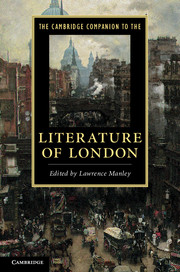Book contents
- Frontmatter
- Introduction
- 1 Images of London in medieval English literature
- 2 London and the early modern stage
- 3 London and the early modern book
- 4 London and poetry to 1750
- 5 Staging London in the Restoration and eighteenth century
- 6 London and narration in the long eighteenth century
- 7 London and nineteenth-century poetry
- 8 London in the Victorian novel
- 9 London in Victorian visual culture
- 10 London in poetry since 1900
- 11 London and modern prose, 1900-1950
- 12 Immigration and postwar London literature
- 13 Writing London in the twenty-first century
- 14 Inner London
- Guide to further reading
- Index
8 - London in the Victorian novel
Published online by Cambridge University Press: 28 September 2011
- Frontmatter
- Introduction
- 1 Images of London in medieval English literature
- 2 London and the early modern stage
- 3 London and the early modern book
- 4 London and poetry to 1750
- 5 Staging London in the Restoration and eighteenth century
- 6 London and narration in the long eighteenth century
- 7 London and nineteenth-century poetry
- 8 London in the Victorian novel
- 9 London in Victorian visual culture
- 10 London in poetry since 1900
- 11 London and modern prose, 1900-1950
- 12 Immigration and postwar London literature
- 13 Writing London in the twenty-first century
- 14 Inner London
- Guide to further reading
- Index
Summary
Mid-nineteenth-century London acquired its breadth, depth, and density as a fictional space almost entirely through the work of Charles Dickens. Many of his contemporaries set their novels in London, of course, establishing networks of social and economic relationships that depend on the proximities afforded by a capital city. But it was Dickens who discovered how to blend his intimate walking knowledge of the city with fictional techniques that would create London on the page from a variety of perspectives. Although 'Dickens's London' may conjure up immediate images of dense, sooty fog, or labyrinthine courts and alleys, these features take their places in a far wider repertoire of imaginative strategies by which Dickens took hold of a vast, heterogeneous city with an evocative power that continued to influence fictive Londons well into the twentieth century.
The sheer scope of Dickensian London becomes clear when we glance at other mid-Victorian novels set in the metropolis. William Thackeray’s Vanity Fair (1847), for instance, follows standard novelistic procedure in setting up a small number of households in which much of the London action will unfold. These households are class-coded through street names that ‘everyone’ in a middle-class readership could be supposed to recognise: the rich merchant Osborne and the wealthy old lady Miss Crawley live at Park Lane, while the bankrupt adventuress Becky Sharp takes a house nearby in Curzon Street, Mayfair.
- Type
- Chapter
- Information
- The Cambridge Companion to the Literature of London , pp. 142 - 159Publisher: Cambridge University PressPrint publication year: 2011
Accessibility information
- 2
- Cited by

